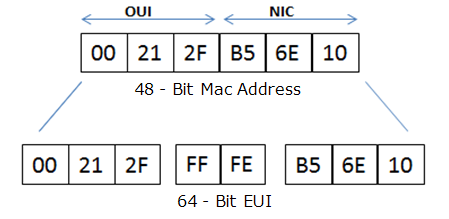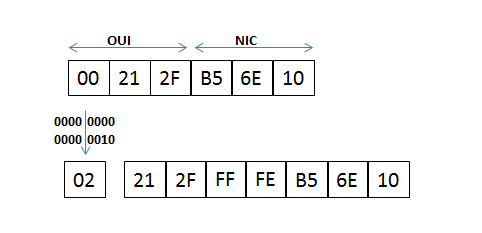Introduction
Extended Unique Identifier (EUI), as per RFC2373, allows a host to assign iteslf a unique 64-Bit IP Version 6 interface identifier (EUI-64). This feature is a key benefit over IPv4 as it eliminates the need of manual configuration or DHCP as in the world of IPv4. The IPv6 EUI-64 format address is obtained through the 48-bit MAC address. The MAC address is first separated into two 24-bits, with one being OUI (Organizationally Unique Identifier) and the other being NIC specific. The 16-bit 0xFFFE is then inserted between these two 24-bits for the 64-bit EUI address. IEEE has chosen FFFE as a reserved value which can only appear in EUI-64 generated from the an EUI-48 MAC address.
Here is an example showing how a the MAC Address is used to generate EUI.

Next, the seventh bit from the left, or the universal/local (U/L) bit, needs to be inverted. This bit identifies whether this interface identifier is universally or locally administered. If 0, the address is locally administered and if 1, the address is globally unique. It is worth noticing that in the OUI portion, the globally unique addresses assigned by the IEEE has always been set to 0 whereas the locally created addresses has 1 configured. Therefore, when the bit is inverted, it maintains its original scope (global unique address is still global unique and vice versa). The reason for inverting can be found in RFC4291 section 2.5.1.

Once the above is done, we have a fully functional EUI-64 format address.
Another doubt or frequently asked question is, are IPv6 devices (routers etc) today doing anything to that universal/local bit? Currently, nothing is being done be the U/L bit 1 or 0. However, per RFC4291 2.5.1 (The use of the universal/local bit in the Modified EUI-64 format identifier is to allow development of future technology that can take advantage of interface identifiers with universal scope), this may change in the future as the technology evolves.
Note: The command to assign an IPv6 EUI-64 format address is {ipv6 address ipv6-prefix/prefix-length eui-64}
Example


References
IPv6 Autoconfiguration
Cisco IOS IPv6 Command Reference